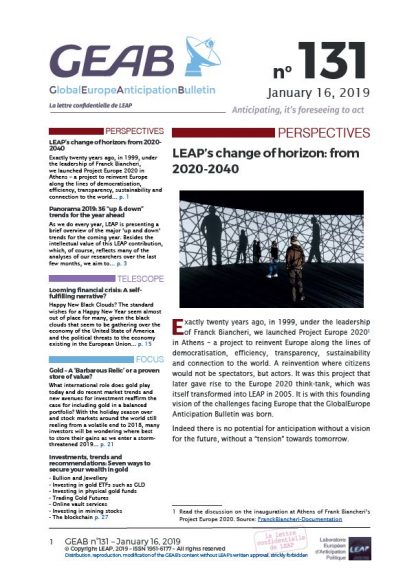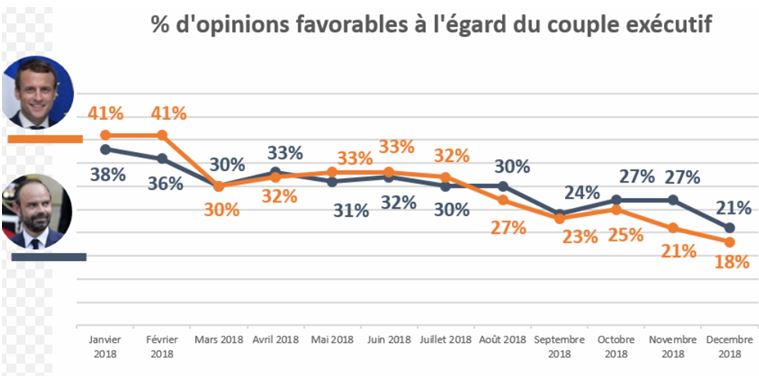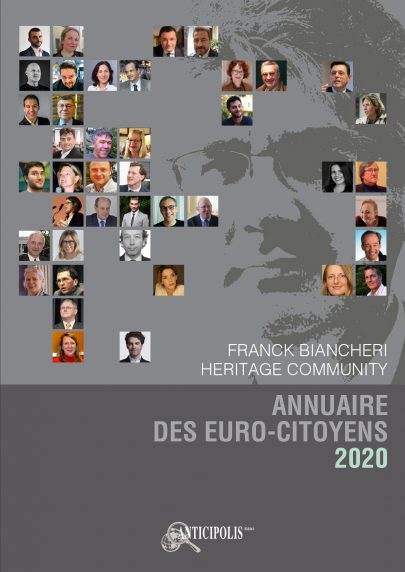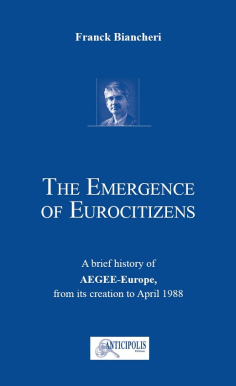GEAB 131


As every year, LEAP is presenting a brief overview of the major ‘up and down’ trends[1] for the coming year. Besides the intellectual value of this contribution, which, of course, reflects many of the analyses of our researchers over the last few months, the aim is to provide a better understanding of the main issues together with some recommendations. This schedule can thus provide readers of the GEAB with some very practical help in preparing for the coming year. This January exercise is rated one year later in the December edition as part of the yearly evaluation of our work. With success rates varying between 68% and 85% over the past 13 years, this work of anticipation should be a particularly effective decision-making aid for 2019.
To make for an easier reading of this overview, we have decided to present our trend anticipations for 2019 in a thematic way.
Governance
Structuring trend: The great rapprochement of nationalist ‘populists’[2] and supranational administrative structures
This rapprochement will take different paths in different cases: political takeover of the establishment (EU), takeover by the traditional parties once the ‘populists’ have carried out their reforms (Greece), partisan compromises (United States and India), adoption of populist agendas by the administrations (WTO[3]), etc. Whatever the method, the arm wrestling that has characterised the relationship between the nationalist ‘populists’ and the supranational technocracies will slowly disappear in 2019. The gradual rise to power of the ‘populists’ is currently helping this new political generation to grow up, while proving to administrations how much they need this embodiment of power to apply solutions.
Upward trend – International organisations and treaties
For a number of years now, we have been describing the gradual decline of the international institutions of the 20th Century. During the past year, several of them have been dealt death blows, most notably by Donald Trump. But we believe that, in 2019, some convincing reform work will be undertaken that could put some of them back on their feet – in particular, the WTO, but also the Nuclear Non-Proliferation Treaty. The latter is having the dust blown of it by the Netherlands and Poland, who are launching a vast inter-national consultation aimed at producing a new, more consensual, document on the occasion of the 50th anniversary of the Treaty (2020).[4] We will see if other institutions follow this path.
Downward trend – Peoples’ anger
Social movements, which are becoming increasingly prevalent in the world, are the main reason for the advent of administrations with so-called ‘populist’ political viewpoints. While impatience has grown throughout 2018, and will continue to grow for several months still, we expect a gradual reversal of this trend, especially in Europe and following the European elections, as part of a better appreciation of popular concerns (by the new rights), advances in democratic innovation (by the new lefts) and a widespread tightening of control (Internet, reinforced security etc.).

Figure 1 – Popularity of the French Executive, February 2018 / January 2019. Source: YouGov
Upward trend – European Politics
Despite all the worrying aspects of the upcoming European election, there is no doubt that it will be more democratic and more European than it has ever been, featuring new transnational parties (Diem25), national parties truly organised around European schedules and agendas (European Greens, Europe of liberties, and perhaps even the European Liberals[5]), newly mobilised citizens (the yellow vests gradually becoming Europeanised[6] and coming together, without even realising it yet, in time for the elections). The camps are very radicalised but, paradoxically, they are united in a general objective to gain political control of the European institutions. And, in fact, these European political forces, once installed in the European Parliament, if not in key positions of the European technocracy, will have sufficient coherence to put forward their views.
Downward trend – Freedom, human rights, tolerance
While the democratic principle is reaffirmed within the previous point, it is in a context of such social disintegration that it is inevitable that 2019 will see a step towards a tightening of control over our societies (migratory flows, surveillance of populations, etc.), presenting, of course, significant risks of totalitarian drift. As we keep saying, to be successful, this ‘democratisation’ of the supranational system of governance should have been carried out thirty years ago in a less explosive context.
Upward trend – New forms of citizen organisation
But citizens will not be helpless in the face of a high-tech hardened supranational political-institutional system. The cleansing has been made up of traditional party systems; the crisis of representative democracy is now openly identified; technological solutions are emerging to regenerate the articulation between citizens and decision-making systems (like the Rousseau platform[7] of the 5-star movement); yellow vest type movements have put citizens back in touch, also contributing to the maturing of political thought and reaffirming the importance of collective action; increasingly innovative types of political party are emerging… In 2019, we will still be at the beginning of this trend, yet we invite our readers to pay attention to these first manifestations.
Upward trend – Cities
A new level of the global governance architecture is emerging, which is more relevant than that of the regions in which they were previously diluted: cities. These are gradually appearing as the basic unit of human organisation. Being as close to the citizens as possible, cities are being transformed into laboratories of social and technological innovation. Connected to each other far beyond national borders, they escape friction-causing territorial thinking to offer a new geography of island-cities with almost self-sufficient vocations, surrounded by areas that can be managed jointly. No wonder politicians at the national level are flying to the metropolises[8] that are now perceived as the real places of ‘transformative power’. We will continue to look out for indicators of this long-term trend.
Downward trend – Brexit
Whether the divorce is actualised or postponed, the extreme tensions generated by the imminent approach of the deadline will soon fade away and the subject of Brexit is destined to move out of the spotlight in European and British news. So much for the trend… Now an example of a way out of the present crisis: a no-deal is impossible (now requiring the approval of the British Parliament), but there is no deal either (the agreement negotiated by T. May is not accepted by her Parliament). Therefore, Brexit will be postponed. As a result, British citizens will be part of the first truly European election[9], capable of connecting them to the continent and creating the conditions for a ‘yes’ in a second referendum to decide whether or not to stay in a de facto radically transformed Europe. We would then have a perfect win-win situation for all: The United Kingdom has enabled the EU to be transformed; the EU has reaffimed its indispensable nature; and the GEAB, which had anticipated that there would be no Brexit!
Eco- Fi-Mon
Structuring trend: Simplification
The increasingly obvious failure of the conventional financial system to serve the potential and need for economic growth has resulted in so much complexity that no one understands it anymore. As long as things were pretty much working, ‘faith’ in this system could persist; but it needs to be recognised that repeated failure has challenged this blind faith and resulted in the outright disengagement of economic players. It is interesting to learn that Uber recently decided not to be listed on the stock market, judging the system not reliable enough.[10] In the same vein, BoE Governor Mark Carney recently said that ‘the evolution of the global financial system is currently lagging behind that of the global economy’. This is a huge slap in the face on the part of a leading authority in the system in question, likely to have far-reaching consequences. The incomprehensible nature of this system is, in fact, only a reflection of its dysfunction. 2019 should see the beginning of a process of rationalising and simplifying the financial system and re-establishing it in economic reality.
Upward trend – The reform of global financial and monetary systems
For the reasons stated above, the financial crisis will increasingly be seen as a crisis of the system itself. The awareness that the economy is doing better than finance, that the financing mechanisms of said economy have moved beyond the scope of Western finance (shadow banking, etc.) and that, not only Chinese companies, but now US companies emblematic of the new tech, no longer seek to subscribe to this system (Uber) or even try to get out (Tesla[11]), is likely to initiate a process of structural reform (not just attempts at regulation). We could see the first major signs of this in 2019, following the lines we indicate in this overview.
Downward trend – The dollar
The first game changer is the dollar’s loss of momentum as a strong currency and hence as a pillar of the monetary and financial system. As mentioned before, the current US President is not in favour of a strong dollar himself: to reindustrialise his country and re-establish his trade balance, in particular, he needs a weak dollar.
Login

Exactly twenty years ago, in 1999, under the leadership of Franck Biancheri, we launched Project Europe 2020 in Athens – a project to reinvent Europe along the lines of democratisation, [...]
Happy New Black Clouds? The standard wishes for a Happy New Year seem almost out of place for many, given the black clouds that seem to be gathering over the [...]
What international role does gold play today and do recent market trends and new avenues for investment reaffirm the case for including gold in a balanced portfolio? With the holiday [...]
Bullion and Jewellery For centuries, gold coins and jewellery have been used as small-scale private investments and, for many people today, they remain a good place to start. It must [...]








Comments